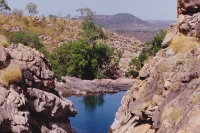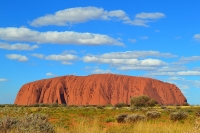Province guides

Attractions
The Northern Territory is best known for its dramatic outdoor attractions: the globally recognisable Uluru (formerly known as Ayers Rock); the Olgas, a remarkable collection of massive domed rocks; Watarrka National Park and the magnificent King's Canyon therein; Kakadu National Park, with its incredible rock art; the Tiwi Islands, home to the Tiwi Aboriginal people; the beautiful, rugged landscapes of Katherine Gorge; and Litchfield National Park, loved for its natural rock pools and waterfalls.
The Northern Territory is also home to some charming towns and cities, and popular travel bases include Darwin, a much-loved tropical, seaside city; Alice Springs, the gateway to the delights of the Australian Outback; Yulara, an isolated resort town situated close to Uluru; Jabiru, a town located within Kakadu National Park; and Katherine, named for the nearby gorge. It is a large but sparsely populated territory and a thorough exploration of the main tourist attractions requires covering quite big distances. Bushwalking, ballooning and fishing are all very popular activities in the region.

Kakadu National Park
This stunning park, covering almost 12,500 square miles (32,375 sq km) was added to UNESCO's list of World Heritage areas in 1984 and is regarded as one of the natural marvels of A…
Kakadu National Park
This stunning park, covering almost 12,500 square miles (32,375 sq km) was added to UNESCO's list of World Heritage areas in 1984 and is regarded as one of the natural marvels of Australia. The land itself is believed to be more than two billion years old, and is a jigsaw of wetlands, gorges, waterfalls, floodplains, rainforest pockets and escarpments.
It offers the visitor an impressive variety of superb landscapes teeming with wildlife, and features some of Australia's most magnificent examples of Aboriginal rock art. About 5,000 Aboriginal sites have been identified in the park area, making it arguably the best destination in Australia for those wanting to experience the oldest living culture on earth. The park can be visited on a day-trip from Darwin and contains more than 1,600 species of plants and 500 different kinds of birds and animals.
Website www.parksaustralia.gov.au/kakadu/index.html

Uluru-Kata Tjuta National Park
Formerly known as Ayres Rock, Uluru rises from the surrounding plains within the Uluru, Kata Tjuta National Park, and belongs to the Anangu Aboriginal people, for whom it holds a s…
Uluru-Kata Tjuta National Park
Formerly known as Ayres Rock, Uluru rises from the surrounding plains within the Uluru, Kata Tjuta National Park, and belongs to the Anangu Aboriginal people, for whom it holds a special spiritual significance. In an isolated spot 280 miles (450km) from Alice Springs, the power of the rock draws hundreds of visitors taken on tours by Aboriginal guides who explain the monolith's importance in Aboriginal culture. A visit to this monolithic rock, the world's greatest, is an awesome experience. It is composed of a type of sandstone that has been exposed through folding, faulting, the erosion of rock and infill. At the base are caves, inlets and overhangs formed by chemical degradation and erosion.
Some opt for the 1,142ft (348m) climb to the top, which takes about 45 minutes and is not for the faint-hearted; however, it should be noted that for spiritual reasons the Anangu people request that visitors not climb the rock. Visitors should try to view Uluru at different times of the day, as a part of the magic of the rock is its constant colour changes in different lights, particularly at sunrise and sunset. Visitors can take a camel tour of the Outback at Uluru, or enjoy an unforgettable flight in a light aircraft or helicopter for a bird's eye view of the monolith.
About 19 miles (30km) from Uluru is another fascinating geological formation on the desert landscape. Known as Kata Tjuta (formerly known as the Olgas), these comprise 36 domes of red-brown earth, the tallest of which, Mount Olga, is 656ft (200m) taller than Uluru. There is a range of accommodation at Uluru, from luxury resorts to campsites. There is also an Aboriginal cultural centre and an arts and craft centre, along with restaurants, swimming pools, galleries, a supermarket, a medical centre and a post office.
Website www.environment.gov.au/parks/uluru


